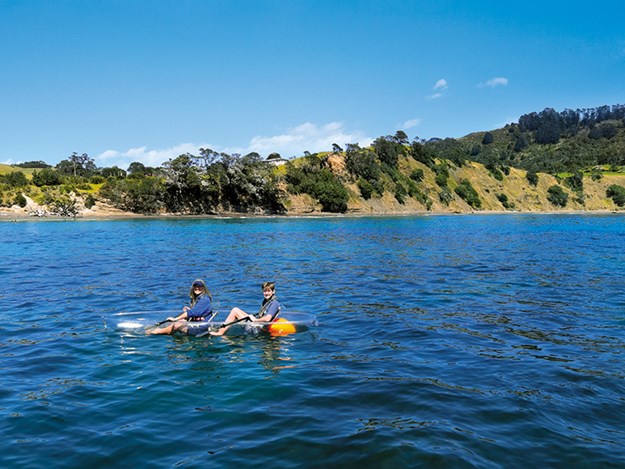 |
|
Elisabeth and Theo enjoy the best seats in the house
|
Not only is Leigh one of the finest beaches in the country for snorkelling, it’s also one of the most accessible, with divers able to enter the water straight from the beach. A designated marine sanctuary that officially opened in 1975, it was the first reserve of its kind in New Zealand and, when legislation put a stop to fishing across this 518-hectare patch of ocean, the aquatic life within its boundaries quickly returned to a state of abundance.
Today the Goat Island Marine Reserve is one of my favourite places to admire fish in their natural habitat, and I only wish the protected area was bigger, and that the perimeters weren’t made obvious by the presence of crayfish pots and lurking spear fishers waiting for hapless snapper to stretch a fin beyond the boundaries.
The drive to Leigh is a pleasant 80km from Auckland and, once beyond Warkworth, it’s all about pretty country roads that lead to the ocean. Once we’d parked at the top of the hill, and been greeted by the welcome party of ducks, we meandered in jandals down to the pohutukawa-lined shore.
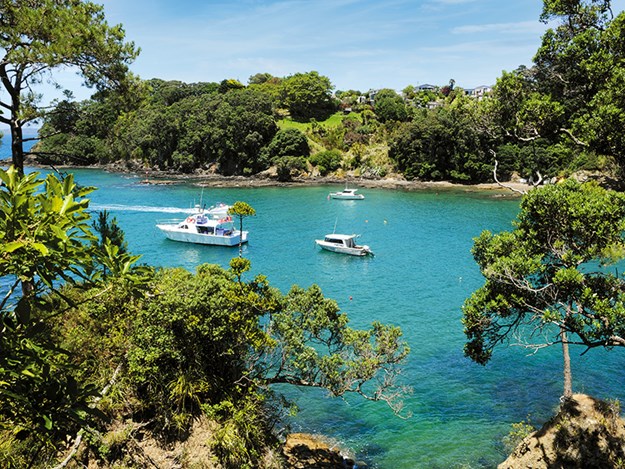 |
|
Leigh Harbour radiates charm
|
It was an outrageously picturesque day, and we kept our eyes and ears peeled for kaka, tui, kereru and korimako (bellbirds). We even spotted a kookaburra. At first we thought it was a super-sized kotare (kingfisher), but closer inspection led us to conclude that the bird on the telephone wire was actually an Australian cousin.
But because it’s not always convenient to snorkel – perhaps it’s not warm enough for your liking, you’ve not brought your togs, or you’re simply not that confident a swimmer – at Leigh there are numerous options for exploring the wonders of the ocean. The glass bottom boat is a perennial favourite. Alternatively, you could explore the rock pools at low tide or opt for the most novel activity and hire a Clearyak.
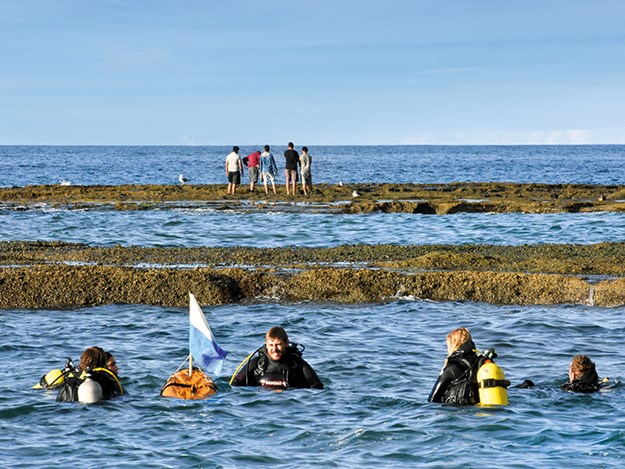 |
|
Leigh is one of the most accessible beaches for snorkelling
|
What is a Clearyak, I hear you ask? Picture a double canoe made of Perspex with a broad beam, a flat bottom and relatively high sides in the style of a Canadian canoe, rather than the sort of craft that has an enclosed cockpit. And being see-through, they reminded me of an aquatic version of Wonder Woman’s invisible plane, which I’d always hankered after. And even though I had my swimsuit with me, I was reassured that the Clearyak should be a dry experience, so I needn’t bother trotting back up the hill to change. Which just made life simpler.
Safety being paramount, Matthew, aka Kip, who runs the business with his dad Antony, aka Griff, started by giving us our instructions. Kip pointed out the outer limits of where we could paddle and then, reading the waves like a pro, he put us in our boat at just the right moment so we only got our feet wet, while also being careful not to let the bottom of the boat scuff the sand. It cannot be said more plainly, but scratches are to be avoided at all costs as they will reduce the visibility for subsequent paddlers.
All Clearyaks are doubles but people travelling solo can easily pilot them alone, so don’t feel you have to bring a friend – although you could just round up a random from the beach!
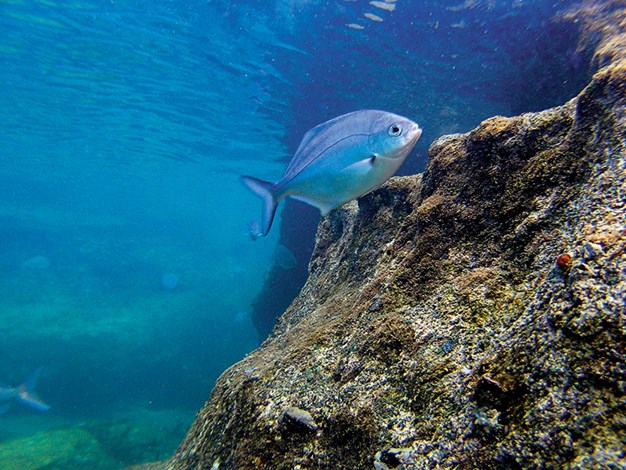 |
|
Blue maomao like to gather around rocks
|
As designated front passenger, I was loaded in first, then my trusty co-pilot and navigator, my son Theo, climbed in behind me, and off we paddled towards Te Hawere-a Maki, Goat Island. At the outset, I felt I needed to focus on where we were going, rather than what was beneath us, as I didn’t want to run aground, but pretty quickly we refocused our attention because the novelty of being able to see beneath the surface of the water while paddling a canoe is ridiculously fabulous. Although we might’ve looked quite strange to people on the beach, being so fixated with the bottom of a boat and what was between our legs, but what did we care?
We began by paddling to the north end of the island, while also ensuring we didn’t get too close to the rocks to cause scratches, where our first creature of note was a seal. A handsome fellow of a decent size, he basked languidly before us and, while I know seals are wild animals, their sweet faces and cat-like whiskers do make me wish I had one for a friend. But this chilled-out blubbery dude had no such desire to befriend me and simply watched us nonchalantly from his vantage point on the rocks. He didn’t move much more than a whisker, let alone balance a ball on his nose, so we returned our attention to the ocean whereupon Theo spotted the first snapper. Just one to begin with, then two, then we spied whole platoons of them swimming beneath us, the sun reflecting off their vibrant blue scale markings.
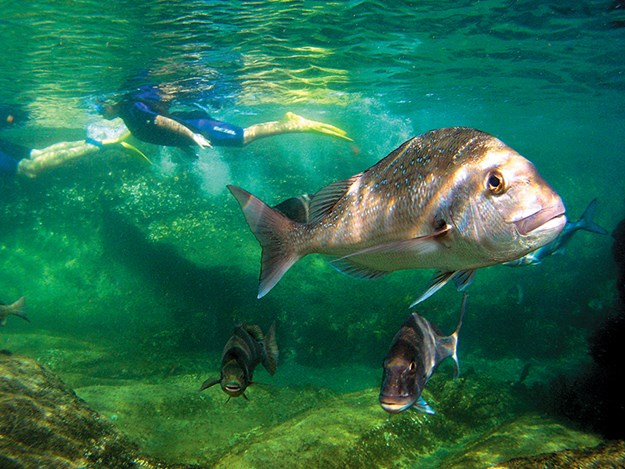 |
|
Snapper and snorkellers
|
When Kip paddled over on a stand-up paddle board to check on his charges – what a great job he has and his radiant smile tells you he knows how fortunate he is – he shared a few fascinating fish facts. One thing we especially loved was that those blue markings on snapper, or tamure, are individual to each fish and a Masters student is currently creating an app that could be used to identify individual snapper.
Red moki were also out in force. Apparently, they breed for life so we were relieved to hear Kip tell us that most spear fishers know this and spare them – although it’s probably not all about kind-heartedness, but rather because red moki are vegetarians and don’t taste particularly nice.
I’ve always been fond of kayaking. It’s so peaceful. There’s no noise, no engine, no fumes; just the simplicity of paddle and paddler. And you see and hear things you’d never notice in a motorboat. But to make the kayak see-through is to turn a pleasant thing into an outrageously fabulous one – although what the fish think of all the squashed flat bottoms, albeit clad, I’ve no idea. I imagine it’s the same view you’d get if you sat on a photocopier and made a print of your derriere at the office Christmas party.
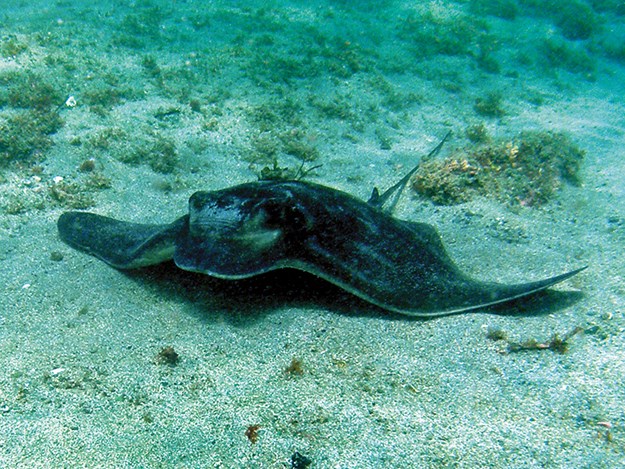 |
|
Eagle rays are frequent visitors to the marine reserve
|
One thing’s certain, with every day at the beach being different due to wind, tide and weather, we will certainly return to Leigh when it’s super-still and glassy because while we had reasonable visibility, I really want to try this again and hopefully see a range of rays, some passing orca or a dolphin or two, which aren’t uncommon sights. I’d also really like to return when the pohutukawa are in bloom so, in the words of Arnold Schwarzenegger, I’ll be back.
Other local treasures
The Goat Island Marine Discovery Centre (run by The University of Auckland) boasts the most amazing visitor centre. The building has won numerous architecture awards and the views are spectacular. The centre features fascinating displays as well as tanks full of crabs, kina, and urchins. Did you know the Japanese mantis shrimp has a powerful spear it can drive through a shell, or your thumb if you’re silly enough to pick one up? Exploring the discovery centre can keep people of all ages occupied for hours and is a good place to enjoy some shade during the hottest parts of the day.
The Goat Island Coastal Walkway starts directly opposite the Marine Centre and makes for a very pleasant wander, leading to Cape Rodney, where sea views and glimpses of Hauturu/Little Barrier Island will make you want to have your camera handy. A modest 3km round trip.
Try snorkelling at high tide in the mangroves of Whangateau Harbour, where you could spot flounder, crabs, mantis shrimps (no touching) and cockles.
Ti Point Reptile Park: This is a fabulous collection of native and exotic reptiles in a truly wonderful location.
Where:
Leigh is 80km from Auckland, and Goat Island is just five minutes drive beyond the township of Leigh. It’s well signposted, and do be sure to pack a picnic as the nearest shop is back at Leigh or, if you fancy more extravagant provisions, you’ll want to stock up in Matakana.
Clearyak tips:
Check the website ahead of travelling to ensure Clearyaks are operating, or just make a phone call as Kip is always happy to provide information based on what’s in front of his face. And if you get to the beach and find it’s not quite what you had hoped for, you’re more than welcome to rebook. For more information visit clearyak.co.nz or call +64204CLR YAK
Find motorhomes, caravans and RVs for sale in NZ





